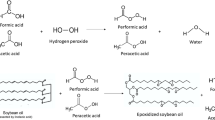Abstract
In previous work we found that ultrasonic energy greatly enhanced the rate of hydrogenation of soybean oil. We have now investigated parameters of ultrasonic hydrogenation and the quality of the resulting products. Refined and bleached soybean oil was hydrogenated continuously with and without ultrasonic energy at different temperatures, pressures and catalyst concentrations. Flavor and oxidative stability of the oils were compared with a commercially hydrogenated soybean oil. The extent of hydrogenation (ΔIV) was not affected by temperature between 245 and 290 C, but was greater at 106 psig than at 65 psig hydrogen pressure. The ΔIV of hydrogenated oils increased linearly with catalyst concentration from 40 ppm to 150 ppm nickel. At the same catalyst concentration the IV drop was significantly increased when ultrasonic energy was used. By reducing the amount of power supplied to the ultrasonic reactor to 40% of full power, the specific power (watts/ΔIV) was lowered by 60%. Linolenate selectivities and specific isomerization (%trans/ΔIV) remained the same, but linoleate selectivities were lower than for batch hydrogenation under varied operating parameters. Flavor scores were not significantly different, initially or after storage eight days at 60 C, for oils continuously hydrogenated with and without ultrasonic energy. Hydrogenation of soybean oil with ultrasonic energy offers a method to produce good quality products at potentially lower cost than present methods.
Similar content being viewed by others
References
Moulton, K.J. Sr., S. Koritala and E.N. Frankel,J. Am. Oil Chem. Soc. 60:1257 (1983).
Schwab, A.W., and H.J. Dutton, Ibid.:57 (1948).
Mounts, T.L., and K. Warner, inHandbook of Soy Processing and Utilization, edited by D.R. Erickson, E.H. Pryde, O.L. Brekke, T.L. Mounts and R.A. Falb, American Oil Chemists’ Society, Champaign, IL, 1980, pp. 245–266.
Moulton, K.J. Sr., S. Koritala and K. Warner,J. Am. Oil Chem. Soc. 62:1698 (1985).
Official and Tentative Methods of the American Oil Chemists’ Society, Third Edition, AOCS, Champaign, IL, revised to 1981, Methods CD 14–61, CD 7–58 and CD 8–53.
Black, L.,J. Am. Oil Chem. Soc. 52:88 (1975).
El’Piner, I.E.,Ultrasound: Physical, Chemical and Biological Effects, Consultants Bureau, New York (1964).
Blitz, J.,Ultrasonics: Methods and Application, Van Nostrand Reinhold Co., New York, 1971.
Author information
Authors and Affiliations
About this article
Cite this article
Moulton, K.J., Koritala, S., Warner, K. et al. Continuous ultrasonic hydrogenation of soybean oil. II. Operating conditions and oil quality. J Am Oil Chem Soc 64, 542–547 (1987). https://doi.org/10.1007/BF02636391
Received:
Published:
Issue Date:
DOI: https://doi.org/10.1007/BF02636391




